Hello and welcome!
As I mentioned in my previous post, last week we had our plenary meeting of the Pontifical Commission for the Protection of Minors.
The Spanish magazine Vida Nueva did a wonderful write-up of the commission and our plenary session.
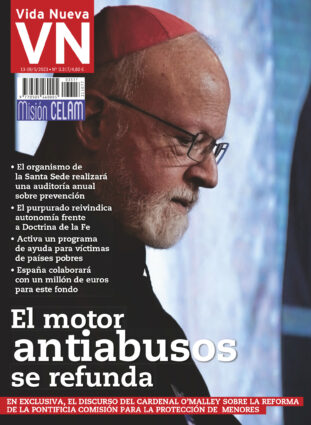
They reprinted the text of my opening address for the session in Spanish, but I’d like to share that here with you in English, as well:
We have gathered to continue the work we began in our first meeting last October, shortly after the new membership was announced, which builds on the work of the Commission since its founding in 2013. Now, as then, we begin by remembering the impact of the evil of sexual abuse — indeed of all kinds of abuse — on so many countless people both inside and outside of our Church. This is our special and irreplaceable focus. This has always been our primary motivation: to accompany those whose lives have been so harmed by abuse and to work diligently to bring about a culture of prevention and care so that such abuse has no place in our Church. We meet in our new offices, assigned to us by the Holy Father, and recently hosted a group of survivors seeking justice for themselves and to inform how the Church should protect all those at risk in its care.
Let me begin by offering a very brief summary of the past 10 years of the Pontifical Commission. In 2013, during our first meetings of the C9, one of the group’s first major recommendations was the establishment of a body to advise the Holy Father on how to address problems related to the sexual abuse of minors in the Church. The Holy Father established the Commission in 2013, and we have been meeting twice a year since then. In September 2022, a third iteration of the Commission was established with 20 members: 10 men and 10 women, 10 new members and 10 former members.
The Commission has always been made up of mostly lay people who’ve felt free to express their strong views on the subject as well as being committed to the well-being of children. Some members have been survivors of sexual abuse. The Commission was organized in different ways — first into 17 sub-groups and, in the second iteration, three working groups. The members have been committed to the goal of preventing abuse within the Church and accompanying victims.
After 10 years and with the benefit of hindsight, it is evident that the Commission has faced challenges from the expectations placed on it by the Holy See or by the members themselves. We were asked “to advise the Holy Father” on how to find a way out of the crisis and a near-impossible task: to fix all the problems related to sexual abuse in the Church, an issue that provokes justifiable passions, and even outrage, on all sides. It is not surprising that the Commission has been a lightning rod for so many and the subject of intense criticism both internally and externally.
The Commission has also been a place of important insight and development. As a voice for victims, the Commission has established an irreversible path of cultural change in the Church’s handling of sexual abuse. This fact should not be underestimated. Key initiatives found their origin in the Commission, such as the February 2019 meeting of all the Presidents of Bishops’ Conferences, the abolition of the pontifical secret in abuse cases, and hundreds of presentations and leadership training all across the Church. Books and seminars on implanting a culture of healing in the different church contexts of the rights of victims in penal processes have disseminated the Commission’s advice through practitioners in the Church. “Vos Estis Lux Mundi” found its first precursor in the Commission’s contribution to “Come Una Madre Amorevole.” The updating of the laws of Vatican City was also closely followed by Commission staff.
However, the challenges of the Commission’s mandate, its standing in the Curia and its authority to bring about change within the Church have remained with us. In 2021, I initiated a period of evaluation of the Commission’s strengths and weaknesses, with a view to the new beginning offered by the Apostolic Constitution “Praedicate Evangelium.” This was a time to correct some of the earlier design flaws and respond to some of these earlier frustrations.
Commission members and other key stakeholders underwent a period of review and debate on how any future Commission should organize itself. From June 2021 to June 2022, briefing papers were drafted and discussed by many of the people in this room with former members, and the Commission was afforded some newly better defined core competencies.
At the heart of the current Commission’s mandate, expressed in Article 78 of “Praedicate Evangelium,” is its responsibility to assist Church entities in adopting and adhering to sound policies and procedures, known as “Guidelines.” Since 2011, almost every Bishops’ Conference has developed a set of Guidelines. In December of last year, the Dicastery for the Doctrine of the Faith delivered all their archives on the history of Guidelines development that they had accumulated since their initial request in 2011. At that time, I sent a circular letter to all the Bishops’ Conferences asking for updated Guidelines; so far, we have received nearly 40 updated Guidelines.
The Commission is currently developing a universal framework for Guidelines that updates the one issued by the CDF in 2011. We will discuss an updated universal guidelines framework in these days in the hope of coming to a consensus on a framework that we can then share with Bishops’ Conferences, Conferences of Religious, the Curia and also victims’ groups from May to September of this year in a spirit of synodality, and receive their comments before issuing an updated framework for Guidelines at the end of this year. From there, we can develop an audit tool, called for by the Holy Father in his audience with us last April, to accompany the Guideline framework and to ensure the adequacy of safeguarding policies and procedures within the Particular Churches.
In his audience with the Commission in April 2022, the Holy Father asked us to pay special attention to helping those parts of the Church with few resources to implement the requirements of “Vos Estis Lux Mundi” article 2. This now-updated document was made permanent by the Holy Father in March of this year and requires the presence of “offices or other entities” in Local Churches that can receive accusations of abuse and of caring for alleged victims and their families. In short, we were asked not only to evaluate the adequacy of policies and procedures in Local Churches but to help build capacity where there are gaps because of a lack of expertise or resources. We are tentatively calling this capacity-building initiative the Memorare Program, in honor of the prayer to the Blessed Mother, who states confidently that anyone who comes for assistance will not remain unaided. We have already identified pilot programs in Kenya, Rwanda and Bolivia.
Establishing sound policies through Guidelines and building the capacity to implement them through the Memorare Program are the key tools for assisting the Church to improve in this area. However, compliance with good practice and transparency are key elements of this activity. These will be addressed in the Annual Report on Safeguarding Policies and Procedures produced by the Commission and presented to the Holy Father. It is hoped that the Report will be available for publication. More than simply detailing the activity of the Commission, the Report should be a prompt for improving practices within the Church by demonstrating that change is possible and that the Church’s efforts are having the desired result. The Report can also help identify gaps or ongoing concerns in the Church’s prevention and protection measures so that appropriate steps can be taken.
The Commission will focus its advice-for-action mandate provided for in “Praedicate Evangelium” principally through the role and function of Guidelines throughout the Church. Where there are gaps, the Memorare Program will help build capacity, especially in the global south, where the needs remain great. Also, an Annual Report will provide transparency and accountability, showing progress made and challenges that remain.
To implement this plan, the past six months have seen much activity for the Commission’s work. The first major change has involved organizing the members into four regional groups with the aim of establishing and maintaining contact with Particular Churches. If members are to accompany and evaluate Local Churches as they implement safeguarding, they should come from that region and be aware of the culture. This development was discussed during the period of review. To ensure focus and feedback, our work has been organized through the Regional Groups, which have been operating over the last six months.
To guide this encounter and dialogue between the Commission and the local Church as mandated in “Praedicate Evangelium,” we are looking to the ad limina process. Soon after the last Plenary, the Commission developed a draft questionnaire focusing specifically on prevention and safeguarding practices in the local Church and which would accompany the ad limina report that is distributed by the Dicasteries for Bishops, Evangelization and Oriental Churches. The Bishops’ Conferences of Mexico, Colombia and Papua New Guinea have already responded to these questions, making for a much more constructive ad limina process. Also, I recently met with the new Prefect for the Dicastery for Bishops and shared our hopes for a more incisive role in the ad limina process. We also discussed a proposed Memorandum of Information Exchange, similar to the one signed with the Dicastery for Evangelization.
One of the most significant challenges to the Commission has been the lack of adequate staffing. Our actual budget last year was $350,000, among the smallest in the Curia. The cost for 4 full-time staff and 5 part-time consultants amounts to $200,000, the balance goes to travel and other costs related to the Plenaries and other activities such as seminars and publications. According to the numbers made public by the Secretariat for the Economy, the Dicastery for the Doctrine of the Faith, where we are located in the Curial structure, has a budget of approximately $2 million.
Last year, we secured a small increase in our budget from the Secretariat for the Economy to add one person to our full-time Rome office. However, following the practice elsewhere in the Curia, we sought budget support from the GHR Foundation, based in Minnesota, USA, whose goal is to support the Holy Father’s reform efforts in the Curia. They kindly assigned us up to $500,000 per year for three years, which they used directly to engage staff to support the Commission’s regional group structure. We now have 10 additional staff positions hired directly by the Foundation, so the payments do not pass through the Vatican, to assist our work while remaining located in the regions which they serve. This reflects the Holy Father’s focus on the Particular Churches, maintains a non-Vatican focus, and is perhaps a new model for a decentralized structure.
For many years, the Commission has been in need of meeting space, especially as its role in the ad limina process has expanded. Welcoming victims and survivors has been a priority of the Commission since the beginning. The few cramped converted residences that were once used during Conclave provided us with proximity to the Holy Father’s residence but not much accessibility for the people we want to welcome and assist. After an extensive search and the intervention of the Holy Father himself, the Commission secured space in the office of the Vicariate of Rome near the Pantheon. With room for staff and with a large meeting room for the ad limina visit, the new space in Via della Pigna also has a small mission chapel named after San Giovanni that we can use should we entertain and host visiting groups. At our inaugural Mass, we were delighted to be joined by a group of victims/survivors from Slovenia with whom we also spent time here in Maffei.
Much of the programming in the new Center has yet to be developed, but we intend to invite several survivors to provide input and guidance on the activities of this new space. We have also received many journals and other symbolic items, such as keepsakes, artwork and poetry from survivors that will find an appropriate place in the new offices. We are grateful to the Holy Father and those in the Diocese of Rome for their welcome and support.
In terms of securing adequate resources for capacity building for Local Churches, the Commission began asking Bishops’ Conferences in Europe and North America to consider contributing to a fund that would help provide skills and materials to the Church in the global south. In the United States last year, the Church spent $40 million just for the training and certification of all of its Church personnel. I am sure the numbers in Canada and Europe are also quite high. I fear the funds spent on training and certification of Church personnel in Africa is barely a percentage of that amount. Our capacity-building program, tentatively called Memorare, is seeking contributions that will be disbursed to Bishops’ Conferences based on where the needs are and a clear plan of implementation to respond to those gaps. The Commission would sign a Memorandum of Understanding with the local Bishops’ Conference and Conference of Religious to ensure a one-church approach to whatever plan is eventually developed and submitted for funding. Then, funds would be released to hire a local Memorare Advisor who studies the local situation in view of the Commission’s core criteria and diagnoses what needs to be done. A plan is developed with local Church leadership and then submitted for funding. Our first Memorandum will be with the Church in Rwanda, which is one of our pilot projects.
We were pleased last year when the Italian Bishops’ Conference contributed 1.5 million Euros to this fund, and the Spanish Bishops’ Conference informed us last week that they are contributing close to a further 1 million Euros. The funds are kept in the IOR as required by regulations from the Secretariat for the Economy and are subject to very specific reporting, which has been reviewed and approved by the Executive Council.
In the new Constitution, the Commission was located within the Dicastery for the Doctrine of the Faith. This decision was subject to criticism from observers who felt the Commission would become under the control of the DDF, thereby jeopardizing its independence and its role as a key adviser to the Holy Father. This fear has been firmly put aside by frequent indications from the Holy Father guaranteeing the independence of the Commission from any oversight of the DDF. In his address to the Commission in April 2022, the Holy Father urged the Commission and the DDF to collaborate to produce a working relationship between our two entities.
There has been collaboration on the new Guidelines mandate given to the Commission, with the DDF transferring all its archives in this regard, which is undergoing close analysis by our staff. However, overall efforts at defining this relationship in this regard have been slow. Last year, the Commission drafted a working relationship agreement and submitted it to the DDF following the encouraging words of the Holy Father during his audience with us, where he said, “Your close collaboration with the Dicastery for the Doctrine of the Faith and with other Dicasteries ought to enrich your work, while your work can enrich in turn that of the Curia and the Local Churches. The determination of the most effective ways for this to happen I leave to the Commission and to the Dicastery, to the Dicasteries. Working together, these concretely implement the Church’s duty to protect all those for whom she is responsible.”
Superiors at the DDF had expressed the view that the key definitional document of the relationship will only be found in the Commission Statutes. Draft Statutes for the Commission were submitted to the Secretariat of State late last year reflecting the new mandate. Earlier this year, we received comments on the draft statutes, which offered little by way of substantive clarity on the nature of the relationship between the DDF and the Commission other than to say that a mere ‘reporting’ on the activities of the Commission to the Prefect of the DDF seemed inadequate.
The Secretariat of State has been clear that the Commission does not enjoy the standing or status or jurisdiction afforded to a Dicastery, and is therefore a lesser body in the Curia in terms of standing and jurisdiction and rights to share in the governance functions of the Curia. The topic of safeguarding is therefore absent from the meetings of the Roman Pontiff with the Heads of Dicasteries as well as absent from meetings and activities at the inter-dicasterial level. This seems like a serious gap and one that was not envisaged by discussions on the new Constitution that took place at the C9.
At the same time, the link with the DDF seems to be a wise one. If the Commission had occupied a separate Office in the Curia, there are doubts about how quickly it might impact the life of other dicasteries. Placing the work of prevention alongside the work of discipline is common in many parts of civil society, so the co-location could be productive. However, the equality of the two entities must be maintained for several reasons, not least of which is that the Commission should never be seen to be subject to, and therefore involved in, the discipline or justice system of the Church.
We need to discuss proposals during our Plenary that would maintain the initial insight of placing prevention and discipline alongside each other while maintaining the freedom of exercise for both entities without any conflict of interests.
In a spirit of collaboration among curial entities, the Commission has undertaken dialogue with several dicasteries whose competence has significant overlap with the work of safeguarding. The Commission has proposed a series of Memoranda of Information Exchanges with several dicasteries aimed at identifying areas of common interest and mutual dialogue, such as nominations, formation, care of victims, and the ad limina process. While conversations are ongoing, the Commission recently signed a cooperation agreement with the First Section of the Dicastery for Evangelization focused on the New Churches.
During these days and beyond, let us continue to talk about our life and work, our mandate, how we organize our life better and achieve our goals more clearly. And to be upfront with ourselves and those who are interested in our challenges and our progress. Given the new plan of action developed over the last six months, it is important that we communicate as much as possible. We remain ready to engage with anyone who holds concern for keeping children safe in the life of the Church.
Our Commission, only six months in its new iteration, is in the early stages of an ambitious agenda of growing to a more operational presence. We have made great strides already. There are 114 bishops’ conferences and associated conferences of religious who have Guidelines to review and improve. Helping to provide training where it is lacking and implementing Vos Estis article 2 are also major commitments that have started well and that demonstrate a significant change in attitude towards safeguarding in the Church. Providing an Annual Report that is both credible and that responds to human-centered needs, especially for those impacted by abuse or those who may be at risk in our Church, is also a major effort that provides visibility and accountability to the Commission’s work and that of the whole Church.
I am confident that our first six months have made major strides in this direction. Our mandate is challenging, but I believe we are in a good place and are demonstrating that we are delivering on the Holy Father’s commitment.
Friday morning, I gathered with the members of the commission for a Mass at the Tomb of St. Peter, and later that day, we had a private audience with the Holy Father. Half of the commission’s members were recently appointed, so it was their first meeting with the Holy Father.
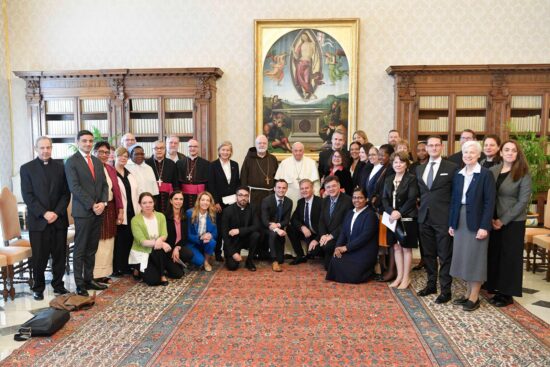
Also with us were a number of our new staff members that we were able to bring on because of help from the GHR Foundation. These are young, well-credentialed professionals in the field of safeguarding. Previously, we only had four full-time staff members. Now, we have staff actually working in the regions, and we have set up regional groups to help bishops’ conferences, particularly those in the Southern Hemisphere that are just beginning to grapple with the issue of safeguarding.
So, with the presence of the new commission members and staff, there was a great sense of energy and enthusiasm in our plenary session.
Every five years, each bishops’ conference is expected to make a report on the activities of their diocese and meet with offices in the Curia, including our commission.
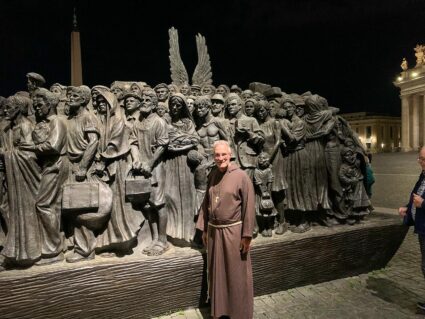
The bishops of Papua New Guinea are currently making their ad limina visit, and I was very happy to see my good friend Bishop Donald Lippert who was among them.
That day, we also met with the Dicastery for the Evangelization. This dicastery oversees the mission dioceses that make up about half the dioceses of the world.
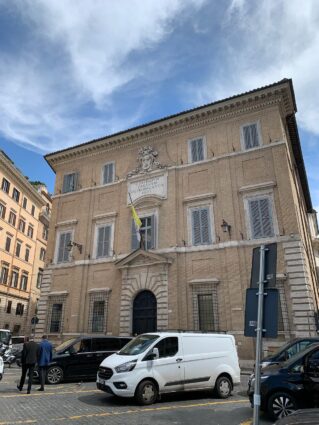
Those dioceses are in parts of the world where the Church is under-resourced and where the issue of child protection is just beginning to be dealt with. So, we have a special interest in them, and the Holy Father wants to support them. As part of that, we have established a fund to award grants to dioceses that need help to initiate programs of education safeguarding.
Saturday evening, I celebrated a Mass with Don Fortunato Di Noto, who was in Rome with a group from his child protection organization in Sicily. Don Fortunato founded the Meter Association (“meter” is Greek for “mother”) in the 1990s and has been one of the pioneers of child protection in Italy.
They attended the Regina Caeli on Sunday, and the Holy Father spoke personally about them. He said:
I greet the Meter Association and its founder Don Fortunato Di Noto, who continue their commitment to preventing and combating violence against minors; today they celebrate the 27th Day of Child Victims; for 30 years they have been defending childhood from abuse and violence. I am close to you, brothers and sisters, and I accompany you with my prayers and affection. Never tire of being on the side of the victim, there is the Christ Child waiting for you, thank you!
I returned from Rome early in the week, and on Wednesday, I was very happy to visit St. Elizabeth’s Hospital as they marked National Hospital and Nurses Week. They held a breakfast for the staff, and I gave them a short talk and a blessing.
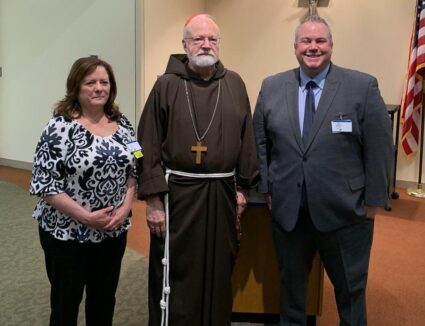
With St. Elizabeth’s Vice President of Clinical Operations Michelle Kap and President Paul Smith
Afterward, I went over to visit with the staff at SECAP (St. Elizabeth’s Comprehensive Addiction Program.) They couldn’t leave their facility to join the breakfast, so I wanted to take the opportunity to greet them and thank them for their important work.
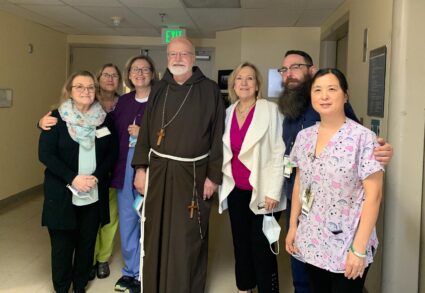
With the team at SECAP
St. Elizabeth’s Medical Center is a place where nurses, doctors and all healthcare workers are committed to collaboration and cooperation on behalf of the people they serve. We are grateful for the leadership of President Paul Smith and his senior leadership team of Dr. Richard Freeman, Kim Basset, and Michelle Kap, and also to Director of Spiritual Care Ellie Goeke.
I well remember receiving my first COVID vaccinations there three years ago, at a time when the virus was taking thousands of lives each day and had upended life as we knew it. In the midst of that crisis, the nurses, doctors, and hospital staff at St. Elizabeth’s continued their mission for the sick and those in need of care. Without them, we would not have been able to move forward on the path to recovery. Each day I give thanks for the service of our nurses, healthcare workers who are there for us in our times of need.
That afternoon, we had the annual board meeting of the St. James Society at the cathedral rectory.
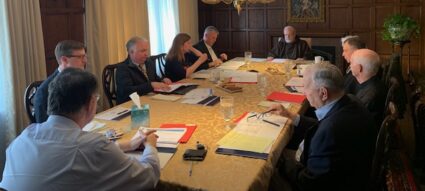
Father Costello gave us a report on the society’s activities and some of the challenges they had during the pandemic, but they seem to be doing very well now. We also heard about Bishop Hennessy’s recent visit with them.
Later that day, I was visited by Archbishop Bashar Warda of Erbil, Iraq, who came accompanied by the president of the Catholic University of Erbil, Dr. Nazar Shabila, and our local Chaldean Catholic Deacon Sermed Ashkouri.
During our visit, they talked about the situation in their country and the great challenges that the Christian community is facing there. Archbishop Warda told me that, in the past, Catholics and Christians had made up about 20 percent of the population, and today they are only about 3 percent. It was very alarming to hear how Christians have been driven out of that part of the world.
Until next week,
Cardinal Seán
